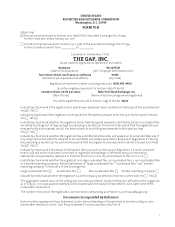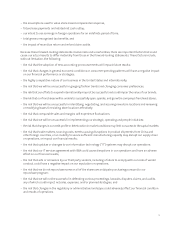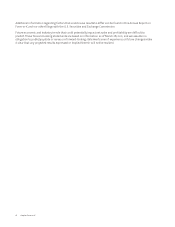Banana Republic 2010 Annual Report Download - page 18
Download and view the complete annual report
Please find page 18 of the 2010 Banana Republic annual report below. You can navigate through the pages in the report by either clicking on the pages listed below, or by using the keyword search tool below to find specific information within the annual report.Fluctuations in the global specialty retail business especially affect the inventory owned by apparel retailers, as
merchandise usually must be ordered well in advance of the season and frequently before fashion trends are
evidenced by customer purchases. In addition, the cyclical nature of the global specialty retail business requires us
to carry a significant amount of inventory, especially prior to the peak holiday selling season when we build up our
inventory levels. We must enter into contracts for the purchase and manufacture of merchandise well in advance
of the applicable selling season. As a result, we are vulnerable to demand and pricing shifts and to suboptimal
selection and timing of merchandise purchases. In the past, we have not always predicted our customers’
preferences and acceptance levels of our fashion items with accuracy. If sales do not meet expectations, too much
inventory may cause excessive markdowns, and therefore, lower than planned margins.
Our products are subject to risks associated with global sourcing and manufacturing, including
increased product costs.
Independent third parties manufacture nearly all of our products for us. As a result, we are directly impacted by
increases in the cost of those products.For example, cotton prices have risen substantially since the beginning of
fiscal 2010, and we expect them to continue to rise in fiscal 2011. The current increases in commodity prices,
specifically cotton, may put pressure on our average unit costs and may impact our gross margins.
If we experience significant increases in demand or need to replace an existing vendor, there can be no assurance
that additional manufacturing capacity will be available when required on terms that are acceptable to us or that
any vendor would allocate sufficient capacity to us in order to meet our requirements. In addition, for any new
manufacturing source, we may encounter delays in production and added costs as a result of the time it takes to
train our vendors in our methods, products, quality control standards, and environmental, labor, health, and safety
standards. Moreover, in the event of a significant disruption in the supply of the fabrics or raw materials used by
our vendors in the manufacture of our products, our vendors might not be able to locate alternative suppliers of
materials of comparable quality at an acceptable price. Any delays, interruption, or increased costs in the
manufacture of our products could result in lower sales and net income.
Because independent vendors manufacture nearly all of our products outside of our principal sales markets, third
parties must transport our products over large geographic distances. Delays in the shipment or delivery of our
products due to the availability of transportation, work stoppages, port strikes, infrastructure congestion, or other
factors, and costs and delays associated with transitioning between vendors, could adversely impact our financial
performance. Manufacturing delays or unexpected demand for our products may require us to use faster, but
more expensive, transportation methods such as aircraft, which could adversely affect our gross margins. In
addition, the cost of fuel is a significant component in transportation costs, so increases in the price of petroleum
products can adversely affect our gross margins.
Our efforts to expand internationally may not be successful and could impair the value of our brands.
Our current strategies include international expansion in a number of countries around the world through a
number of channels and brands. For example, we currently plan to open additional Gap stores in Europe and China,
expand Banana Republic in Europe, open additional outlet stores in Canada, Europe, and Asia, and grow online
sales internationally. We have limited experience operating in a number of these countries. In many of these
countries, we face major, established competitors. In addition, in many of these countries, the real estate,
employment and labor, transportation and logistics, and other operating requirements differ dramatically from
those in the places where we have experience. Moreover, consumer tastes and trends may differ in many of these
countries, and as a result, the sales of our products may not be successful or result in the margins we anticipate. If
our international expansion plans are unsuccessful or do not deliver an appropriate return on our investments, our
operations and financial results could be materially, adversely affected.
We also have entered into franchise agreements with unaffiliated franchisees to operate stores in many countries
around the world. Under these agreements, third parties operate, or will operate, stores that sell apparel and
related products under our brand names. However, prior to fiscal 2006, we had no experience operating through
these types of third-party arrangements, and we can provide no assurance that these arrangements will be
successful. The effect of these arrangements on our business and results of operations is uncertain and will
11
























